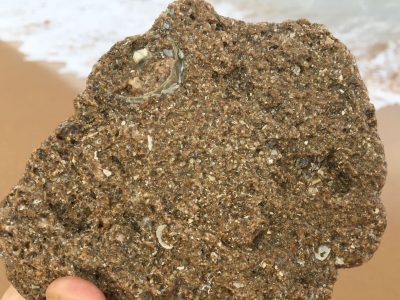Beachrock

Way back in 1962, I collected a sample of calcareous sandstone on the beachface at Fisherman’s Beach, Collaroy. At this time I was heading to Louisiana to study at the Coastal Studies Institute. R.J.Russell was the Director and had an international project underway on beachrock. Desperate to show my interest in this subject I showed him the sample. To my surprise he dismissed it as true beachrock because it was outside the latitudinal range where he believed it occurred. Later he revised this range especially after noting its occurrence at Myrtle Beach, South Carolina. But the more tropical distribution excluding these sites can be seen in global map compiled from different sources by Jack Davies (Geographical Variation in Coastal Development, 1972, Fig. 82). Roger McLean has observed what may be beachrock lying on top of bedrock at Bawley Point on the NSW south coast plus it occurs at the shore on Long Reef and Collaroy-Narrabeen Beaches.
Russell was also interested in my work on Isla del Carmen, Mexico. This is a barrier island rich in carbonate sand and beach ridge topography (Thom, 1969, Zeitschrift fur Geomorphologie, 13, 4, 406-413). Easternmost ridges are truncated as the shoreline recedes exposing a calcarenite which I termed “beach-ridge rock”. This rock extends landwards beneath the ridges with characteristic sedimentary structures of beach deposits. From pit inspection I hypothesised that lithification occurred in these deposits at depths of 1-5m by carbonate leaching and precipitation similar to aeolianite. This was not “true” beachrock!
My next encounter with beachrock was the campsite on Bewick Island on the northern GBR, the location of one of our drill holes as part of the GBR 1973 Expedition. Here the beachrock occurs within the sand cay on the leeward side of the island. Roger Mclean and Terry Scoffin undertook an extensive and very impressive study of beachrock on this and other cays in the northern GBR (Phil. Trans. Royal Soc. London, 291 119-138). They found the cement mineralogy to be aragonite (fibrous crystals) in contrast to that of the so-called rampart-rock found on windward edges composed of coral branches with high magnesium calcite cement. They noted that beaches on sand cays are kept free of fines and are bathed in open-shelf water throughout the tidal cycle. The geochemical environment for rampart-rock is more complex.
Beachrock at Fisherman’s Beach, Collaroy, as far as I can tell was first recorded by Edgeworth David in a note on calcareous sandstone in the Journal Royal Society NSW in 1893 ( v.27,p.406). Smith and Iredale in 1924 (J. Roy. Soc. NSW, 58, 157-168) noted slabs of “beachrock” containing shells characteristic of modern beaches occurring between tidemarks on the present-day shoreline “in a direct line with Florence Avenue”. I am indebted to Peter Mitchell for providing me with unpublished petrological reports by John Byrnes that referred to this paper and the work by Byrnes on beachrock on northern Sydney beaches (Geological Survey of NSW, GS 1982/199 and 229). I think this is the site I visited in 1962. It is currently exposed following storms in 2016. In 1982 Byrnes observed seven slabs, two of which were partly submerged at low tide. Five of the slabs have a gentle seaward dip.
Byrnes thought the cement of the rock at Fisherman’s Beach was probably calcite. However, a sample he subjected to X-ray diffraction from Palm Beach indicated the cement to be “strongly magnesium calcite” and “there is no stoichiometric calcite admixed”. I am not sure what that means, but it is clear from other studies that the geochemistry of beachrock is complex. Russell in his 1962 paper had x-ray studies on several samples that showed the cement to be calcite although aragonite could be present in subordinate amounts (Zeit. Fur. Geom. 6, 1-16). More work needs to be done on Fisherman’s Beach materials.
From what I can gather, true beachrock originates at a level closely approximating the intertidal zone. According to Russell (1962), it serves as an excellent guide to the relationship between levels of land and sea. I would be a bit more cautious as there may be circumstances where cementation can occur outside the tidal range by a meter or so. There is also the issue of confusing true beachrock with exposures of calcarenite derived from subaerial leaching into beach ridge sands (my beach-ridge rock!) or aeolianite.
True beachrock appears to occur at the interface of fresh water and sea water. Sands need to be rich in carbonate allowing for ground-waters to be super-saturated in calcium carbonate so that precipitation can occur at the right temperature and water level. Whether there are biochemical processes involved as well is not clear. On these Sydney beaches its occurrence suggests relatively stable shoreline position over last several thousand years. During erosion events the rock slabs become exposed. Onshore sand transport later covers the slabs. The history of beaches such as Collaroy-Narrabeen appears consistent with this idea. But the slabs can create problems; during WW2 they obstructed some landings on atolls in the Pacific. They may appear to be a solid foundation, but often their friable and shallow nature should make those involved in protection works or building foundations very wary of their strength.
I would like to thank the following for information relevant to this blog: Andy Short, John Hudson, Peter Mitchell, Phil Coleman, Angus Gordon, Roger McLean and Peter Horton.
Bruce Thom
Words by Prof Bruce Thom. Please respect the author’s thoughts and reference appropriately: (c) ACS, 2017, posted 14 December 2017, for correspondence about this blog post please email admin@australiancoastalsociety.org
#98


 Higher Tides
Higher Tides